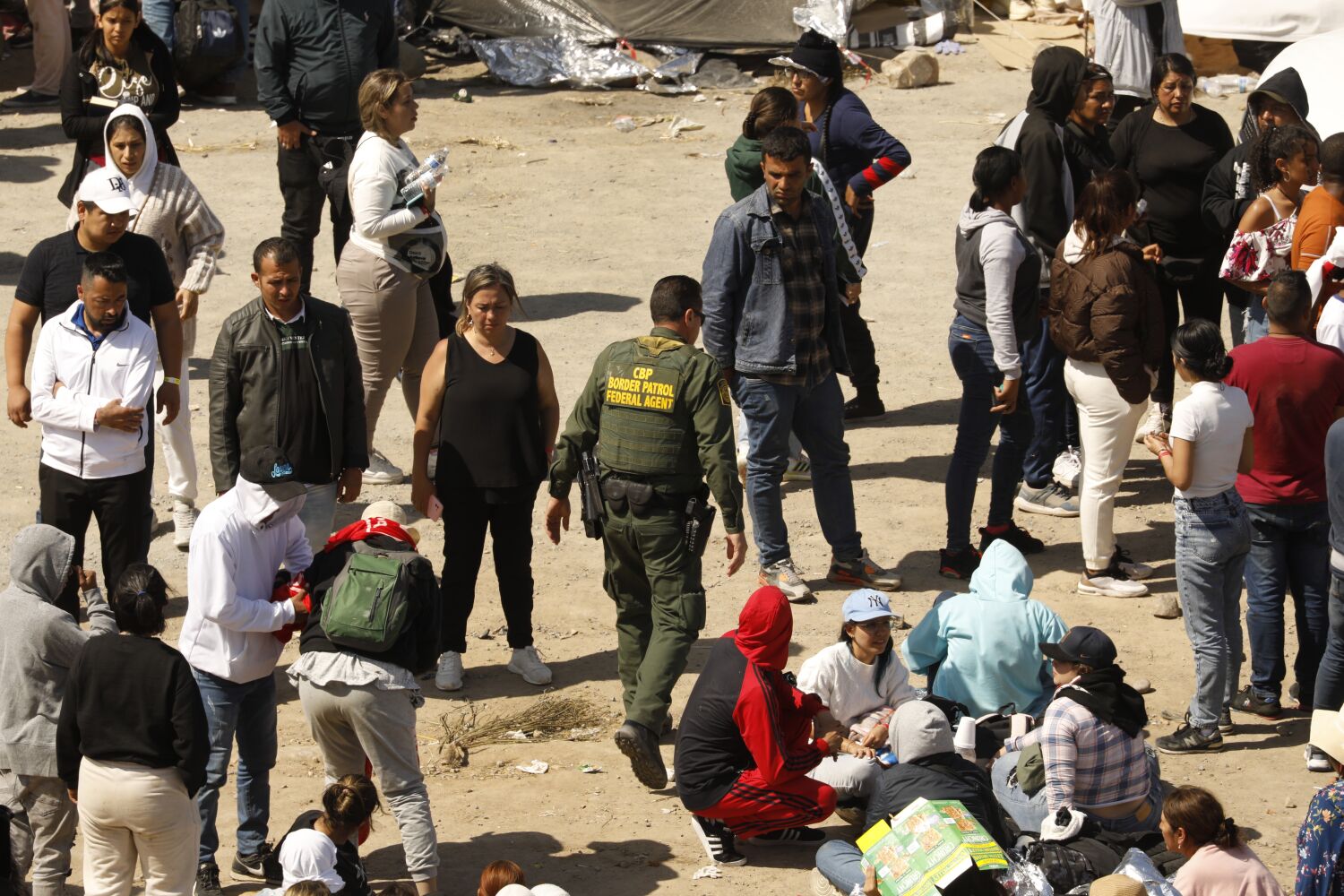Global Courant 2023-05-11 19:51:47
WASHINGTON—
Title 42, a decades-old public health statute used during the COVID-19 pandemic to keep asylum seekers out of the US, will be lifted Thursday at 8:59 p.m. PST, ushering in a new era for US border control.
Orders under Title 42 were first implemented by the Trump administration in March 2020 and faced legal and political challenges, but remained in effect through President Biden’s first years in office.
Citing the threat of COVID-19, the US government has deported nearly 2.8 million migrants at the border over the past three years without offering them the opportunity to seek asylum. Title 42 brought border crossings to record levels, in part because the nature of rapid evictions made it easier for people to immediately try to cross again.
Title 42 has left a lasting impression, with unprecedented restrictions on the border and uncertainty over the coming weeks.
Here’s what you need to know.
What is Title 42?
Title 42 is a public health and welfare statute enacted in 1944 that gave the U.S. Surgeon General the authority—later transferred to the Centers for Disease Control and Prevention—to determine whether communicable diseases abroad pose a serious threat forms for distribution in the US. either by people or property entering the country.
If the CDC determines that a disease is a threat, it can, with the approval of the president, temporarily ban people from entering the country to avert danger.
That’s what happened at the start of the COVID-19 pandemic. In March 2020, amid rising deaths from the virus, the Trump administration issued a new interpretation of Title 42: U.S. Customs and Border Protection agents could immediately remove anyone entering the country without authorization to prevent the spread of the coronavirus . That action closed the border to non-essential travel in the “interest of public health.”
But it also superseded all other US laws, including statutes granting migrants the right to seek asylum; prevent persecuted persons from being sent back to countries where they would face threats, injury or torture; and protection of unaccompanied children vulnerable to trafficking.
How was Title 42 implemented?
Title 42 appears to have been first applied by the CDC under pressure from former Vice President Mike Pence and from Stephen Miller, a top Trump aide who long tried to restrict immigration. CDC experts objected, saying the policy would do little to contain the spread of the coronavirus and could not be justified in the name of public health.
Interest groups, including the American Civil Liberties Union, have sued the Trump administration over the policy. When President Biden took office, the new administration continued the policy, saying it was “necessary to limit the spread of the coronavirus.” The policy survived challenges to its constitutionality.
The Biden administration later exempted children traveling without a parent from deportation under Title 42. Parents traveling with their children and single adults continued to be denied entry to the country or were swiftly deported. But children traveling with extended family members, such as grandparents, are not considered family units and may be separated at the border, with the children labeled as unaccompanied minors and allowed to enter.
Why has Title 42 sparked controversy?
Legal experts have characterized Title 42 as one of the most controversial and restrictive immigration policies in US history. Lawmakers, including then-California Senator Kamala Harris, called it an unconstitutional “seizure of power by the executive branch.” Immigrant advocates generally expected Biden to scrap enforcement of the measure when he took office.
Public health experts said it was people who refused to get vaccinated, not migrants, that caused the rise in COVID-19 infections in the US. Former CDC officials wrote a letter to the Biden administration condemning the policy as “scientifically unfounded and politically motivated”. Dr. Anthony Fauci, then the nation’s top infectious disease expert, condemned it.
But even as some restrictions on non-essential travel at land ports of entry were lifted, the Biden administration continued to justify Title 42 as necessary to protect migrants, Department of Homeland Security personnel and local communities.
The advocacy group Human Rights First documented more than 13,400 violent attacks on asylum seekers trapped in Mexico during Biden’s first two years in office.
How did Title 42 work?
Under Title 42, migrants were not formally deported, a process that could have consequences such as a five-year ban from the US and criminal charges. Instead, agents took the migrants’ biometric information and returned them to Mexico within hours or flew them back to their home countries.
For decades before the implementation of Title 42, migrants who reached the US and sought asylum or other humanitarian protection were detained or released pending a final decision by the immigration court. But that could take years amid an ever-growing backlog of cases.
Of the nearly 5.6 million people detained by CBP at the southern border since March 2020, about half were deported under Title 42, according to CBP figures. But those rapid deportations caused an increase in repeated attempts to cross the border. stings by migrants being returned to Mexico, increasing the number of persons found. In March, about a quarter of the arrests related to people who had been returned earlier in the same year.
Migrants may also be screened under the United Nations Convention against Torture. Those screenings, which require individuals to prove they are likely to be tortured if deported, are more difficult to pass than traditional asylum interviews.
Federal officials relied on Mexico to receive displaced migrants from parts of Latin America and the Caribbean. Those refused by Mexico who could not be immediately deported entered the US and awaited a longer deportation process.
What happens when Title 42 is lifted?
Migrants seeking asylum must use a mobile phone application, CBP One, to schedule an interview with border agents. The app was riddled with technical issues and offers limited appointments — 1,000 per day — that fill up in minutes. CBP has said it has resolved the technical issues and will prioritize people who have waited the longest for appointments.
On Wednesday, the Biden administration finalized a rule that would largely make migrants ineligible for asylum if they enter the US without authorization and do not apply for protection in another country along the way.
DHS said it will rely heavily on the expedited “accelerated removal process” after May 11 to review migrants’ requests for assistance and deport those who do not qualify within days or weeks. Families will be subject to GPS monitoring and curfews while their cases are decided. Mexico agreed to continue accepting some deported migrants who are not from that country after Title 42 expires.
The administration links enforcement to a number of humanitarian processes. Citizens of Venezuela, Haiti, Nicaragua and Cuba are allowed to apply for temporary legal entry under humanitarian parole if they have a financial sponsor, as long as they do not attempt the trip without authorization.
US officials plan to set up 100 processing centers in the Western Hemisphere, starting with two in Guatemala and Colombia, to pre-screen migrants for their eligibility as refugees and other legal pathways. Officials noted that it would be “weeks” before the first two processing centers open. Another program in the works will reunite families from El Salvador, Guatemala, Honduras and Colombia, as well as those from Cuba and Haiti, who have pending applications for permanent residency (the so-called green card).
Some of these provisions are likely to be challenged in court. Republican-led states have already filed suit to block the parole program, and attorneys like the ACLU are expected to sue over the ineligibility for asylum rule.
What was it like at the southern border leading up to May 11?
Arrivals at the US-Mexico border in the waning days of Title 42 orders have strained the customs and border protection industries, especially in Texas. Last week, Border Patrol agents in McAllen, Texas, told reporters that 6,000 migrants — most of them from Venezuela — were in custody in various facilities, noting that the number was well above the capacity of the Rio Grande Valley sector of 4,600 lay. Agents drove groups of migrants into Mexico three times a day.
Border patrol agents had apprehended more than 10,000 migrants at the southern border on Tuesday, according to internal data obtained by The Times, already reaching levels predicted by US officials for immediately after the policy increases.
DHS has expanded detention capacity at the border and in the US, moving agents to high-traffic areas on the border. The agency this week launched targeted enforcement operations in El Paso, among other places, to quickly deport migrants who entered the US without authorization and have no legal basis to stay.
Times staff writers Karen Garcia and Hamed Aleaziz contributed to this report.







